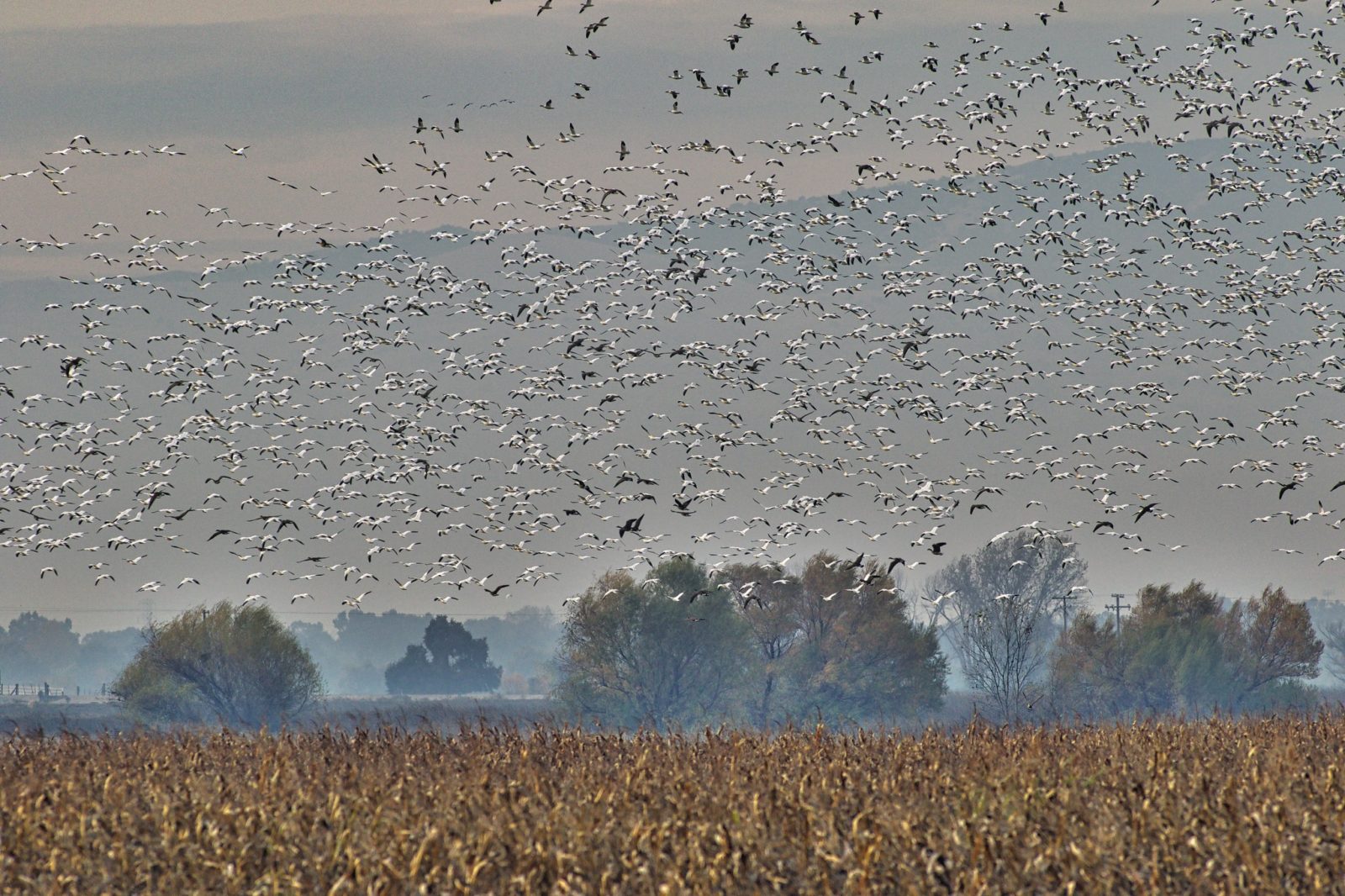On October 7 California Governor Gavin Newsom ordered the state to create a new California Biodiversity Collaborative and conserve 30 percent of its land and coastal waters by 2030.
Conservationists have celebrated the enshrinement of biodiversity preservation among the state’s priorities, as well as the state aligning with an international “30 by 30” goal shared by the United Nations Convention on Biological Diversity, the International Union for Conservation of Nature, and many of the world’s most prominent conservation scientists.
Now comes the hard part: figuring out which 30 percent of California, and making it clear what it means to truly “conserve” it.
After a summer and fall of record-breaking wildfires and arguments between the state and the Trump Administration about who was to blame for them, many Californians now know that 45 percent of the total land area of the state is owned and managed by the federal government. That includes 15 million acres of Bureau of Land Management land, much of which is held in vast swathes of the eastern deserts and inner coast range; 7.6 million acres of National Park Service land; and 20.8 million acres of US Forest Service land.
If you consider California’s federal land more or less protected — it’s publicly owned and rarely ever sold, though it can be developed for solar energy or used for mining, drilling, grazing, and logging — it shouldn’t be hard to rope off 30 percent of the state by 2030. And that’s not all. California State Parks already manages 1.4 million acres. The executive order also mentions the importance of agricultural and working lands, with the first point under the 30 percent line calling for guaranteeing “economic sustainability and food security” — adding the potential for California’s 43 million acres of agricultural land to count toward the goal, too. The order also highlights the importance of marine protected areas, which currently protect one half-million acres in state waters offshore, and tribal lands, which add up to another half-million acres.
All in all, then, it’s defining the nature of “conserve” that will be much more challenging than drawing lines on a map around one third of the state’s land. How much use is too much use? What kinds of use make land count as “not conserved”? How do fishing, hunting, hiking, birding, logging, or ranching factor in? Does a flooded rice field that’s habitat for endangered birds and fish count? Can the state protect 30 percent of its land in a way that reflects its full redwoods-to-desert and coast-to-mountains biodiversity?
A bill in the state Legislature introduced by San Jose Assemblyman Ash Kalra, which would have made the 30 percent by 2030 goal state law, stalled in the Senate over just such a debate, two months before Newsom’s executive order. What counts as “conserved” is now a task for the Biodiversity Collaborative, the group Newsom’s order created to sort out what to protect. “I think about questions like: Is Tilden Park in there or not?” said Jennifer Norris, the deputy secretary of biodiversity and habitat at the California Natural Resources Agency. “Probably, but there’s a lot of recreation in Tilden. So how are we defining that, and what’s the scale? All those questions we need to unpack.”
Norris said that a 2016 US Geological Survey analysis of statewide land put the acreage that’s truly “protected” in California at 22 percent of the state’s 100 million acres. One first step for the new collaborative is simply to figure out what counts and what doesn’t in that assessment.
“Every map makes a series of decisions,” she said. “They’re not including pocket parks, but I’ve got hummingbirds in my front yard. So somewhere between Yosemite and my front yard, there’s a place where we can think about conservation.”
The first part of the executive order calls on the collaborative to bring together several state government agencies plus tribal groups, agricultural groups, and “business and community leaders” to take an inventory of California biodiversity. State leaders seem to be following the order’s intent and not just trying to check off an arbitrary percentage goal, said UC Berkeley biologist David Ackerly, one of the signers of a 2018 California Biodiversity Initiative scientific roadmap. That means scientists will start by going back and looking closely at every acre of land in the state, analyzing it based on criteria from the IUCN to try to prioritize 30 percent that will make a real difference in biodiversity conservation.
“The first step is of course the baseline,” Ackerly said. “It hasn’t actually been done. Most of the data is there but no one’s sat down and said, ‘Here we are, this is our analysis.’ We know wilderness areas will be in there. Motor vehicle parks probably won’t. Somewhere in between. I think the Newsom administration wants to look closely at multiple-use, Forest Service, BLM … and not just sweep things in that really honestly don’t have the highest level of protection.”
Ackerly said the state and scientists will follow four principles for the inventory and subsequent decisions about protection. One is biodiversity, and where the opportunities are to preserve the highest species diversity based on what’s threatened and what land is available. One is climate resilience, which means looking for large land areas and corridors that connect different habitat types. One is what Ackerly labeled “microclimatic heterogeneity” — preserving small but diverse pockets of land for species to move and survive as the climate changes. One is equity in access, and finding parks and preserves that allow everyone to visit.
“California has led the world more than once in tackling the grand challenges of climate change, clean air and water, and stewardship of nature,” said Erika Zavaleta, a biologist at UC Santa Cruz and author of the textbook Ecosystems of California, in a statement of support posted to the new collaborative’s website. “Solving these grand challenges and successfully walking a path of thriving people and nature together calls for all of us to contribute our best ideas and perspectives, and for all of us to be reflected in this movement’s leadership.”
The inventory also offers an opportunity for community involvement. The California Native Plant Society is leveraging its massive network of amateur botanists to find and identify plant species statewide. The California Academy of Sciences will coordinate citizen science projects that help map biodiversity. iNaturalist, the platform operated by the Academy of Sciences, already holds more than 5.8 million observations of California wildlife.
The Academy has also partnered with the Natural History Museum of Los Angeles County and the San Diego Natural History Museum to look for places statewide where there are gaps in biodiversity data. The institutions hope to digitize their vast natural history collections, allowing researchers to study past species from the state, and compare them to present-day observations. The groups also hope to use past and new collections to create a complete library of DNA sequences from every organism in the state, said Rebecca Johnson, the Academy’s co-director of citizen science.
[Disclosure: Johnson is also a member of the Bay Nature board of directors.]
“I think they’re thinking about it in a really cool way that isn’t just ‘Let’s buy this other 8 percent and be done’,” Johnson said. “I like that this order has explicit mention of biodiversity and climate and resilience and ties in lack of data and that we need to protect land, and recognizes people.”
After four years spent fighting the Trump Administration in court over environmental policies, the state could get a boost from its greater philosophical alignment with the incoming Biden Administration. Biden’s campaign platform called for conserving 30 percent of America’s lands and waters by 2030. Newsom said on November 9 that the change in the federal government means “it goes from headwinds to tailwinds.”
“I think California is going to be at the leading edge of those tailwinds,” CNRA’s Norris said. “I hope the federal government would say, ‘Hey, let’s partner and do this together.’ We’re excited to be at the front, at the start, and if we join forces we can put together a national strategy as well. There’s a lot of opportunity to bring federal resources to bear.”
Funding, of course, will still be an issue in the state’s pandemic-ravaged budget.
“We’re not focused on getting new money for new acquisitions or easements,” Norris said. “But there’s so much underway, if we just do it strategically, and the state has a lot of money from bonds. It’s just a matter of spending it in a way that keeps biodiversity front of mind.”





